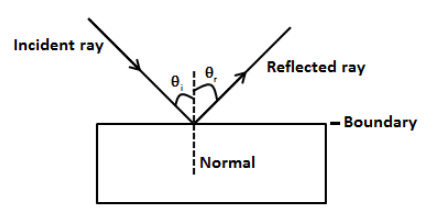
Define angle of reflection?
Answer
556.2k+ views
Hint:When the light ray incident on the certain material, it reflects. The line perpendicular to the boundary between two mediums where the incident ray hit the surface of the other medium is known as normal. The angle made by the reflected ray with the normal defines the angle of reflection.
Complete answer:
We know that when the light ray incident of the material, it either passes through the medium or gets reflected at the boundary. The reflected light is known as reflected ray while the ray which passes through the medium is known as refracted ray.
Now, let’s define the line perpendicular to the boundary between two mediums where the incident ray hit the surface of the other medium as normal. The angle made by the incident ray with the normal is known as incident angle. The angle made by the reflected ray with the normal is known as angle of reflection. The following figure will ease the understanding of angle of incidence and angle of reflection.

When the incident ray falls on the plane surface such as the plane mirror, the angle of reflection equals the angle of incident. If the surface is rough, the angle can be greater or less than the incident angle. The line perpendicular to the surface in the above figure is known as normal, divides the angle of incidence and angle of reflection.
Note: You can also define the angle of refraction as the angle made by the refracted as with the normal. Note that, for reflection to occur, the material on which the light is falling must not necessarily be the opaque. The semi-transparent material also reflects some of the incident light and refracts rest of the incident light.
Complete answer:
We know that when the light ray incident of the material, it either passes through the medium or gets reflected at the boundary. The reflected light is known as reflected ray while the ray which passes through the medium is known as refracted ray.
Now, let’s define the line perpendicular to the boundary between two mediums where the incident ray hit the surface of the other medium as normal. The angle made by the incident ray with the normal is known as incident angle. The angle made by the reflected ray with the normal is known as angle of reflection. The following figure will ease the understanding of angle of incidence and angle of reflection.

When the incident ray falls on the plane surface such as the plane mirror, the angle of reflection equals the angle of incident. If the surface is rough, the angle can be greater or less than the incident angle. The line perpendicular to the surface in the above figure is known as normal, divides the angle of incidence and angle of reflection.
Note: You can also define the angle of refraction as the angle made by the refracted as with the normal. Note that, for reflection to occur, the material on which the light is falling must not necessarily be the opaque. The semi-transparent material also reflects some of the incident light and refracts rest of the incident light.
Recently Updated Pages
Master Class 10 General Knowledge: Engaging Questions & Answers for Success

Master Class 10 Computer Science: Engaging Questions & Answers for Success

Master Class 10 English: Engaging Questions & Answers for Success

Master Class 10 Social Science: Engaging Questions & Answers for Success

Master Class 10 Maths: Engaging Questions & Answers for Success

Master Class 10 Science: Engaging Questions & Answers for Success

Trending doubts
Which of the following does not have a fundamental class 10 physics CBSE

10 examples of evaporation in daily life with explanations

State and prove the Pythagoras theorem-class-10-maths-CBSE

State BPT theorem and prove it class 10 maths CBSE

What is UltraEdge (Snickometer) used for in cricket?

What are the public facilities provided by the government? Also explain each facility




